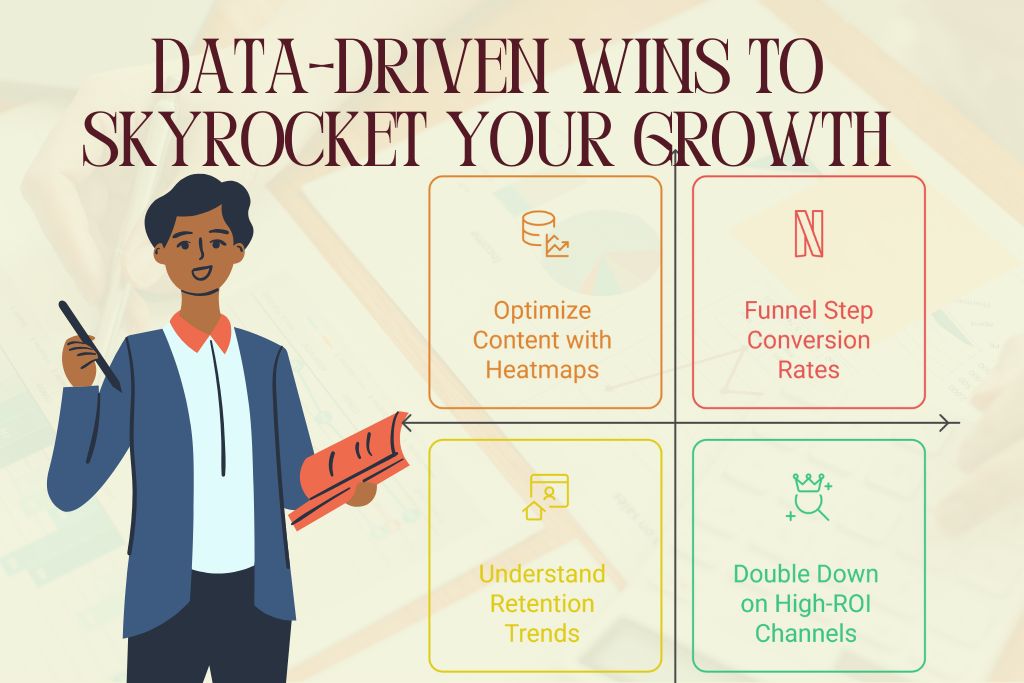7 Data-Driven Marketing Strategies That Deliver Instant Results

In today’s hyper-competitive digital market, “gut feeling” is a gamble you can’t afford. The world’s fastest-growing brands — from Nike to Netflix — aren’t making marketing decisions based on hunches. They’re powered by data-driven strategies that take the guesswork out of growth.
Here’s the good news: You don’t need a massive budget or a Silicon Valley tech team to start winning with data. We’ve pulled together 7 actionable, real-world marketing wins that you can steal today and apply to your brand — no matter your size or industry.
1. Use Predictive Marketing Analytics to Spot Your Next Best Customer
Why it Works:
Predictive analytics lets you forecast customer behavior before they even click “buy.” By analyzing past purchasing patterns, demographics, and engagement history, you can create laser-focused campaigns that convert.
Real-World Example:
Amazon’s recommendation engine drives 35% of its total revenue — all powered by predictive analytics.
How You Can Steal It:
-
Install a predictive analytics tool like HubSpot or Pecan AI.
-
Analyze historical customer data to predict the next purchase cycle.
-
Send personalized offers before your customer starts searching.
2. Track Micro-Conversions to Boost Your Macro Goals
Why it Works:
Everyone tracks sales, but the real magic happens when you monitor micro-conversions — small actions that lead to the big win.
Example Micro-Conversions:
-
Clicking “Read More” on a blog post.
-
Watching 75% of a product video.
-
Adding a product to the wishlist.
Real-World Example:
Airbnb tracks everything from page scroll depth to listing favorites. This helps them refine user experience and nudge users toward booking.
How You Can Steal It:
-
Set up Google Analytics 4 event tracking.
-
Reward engagement milestones with pop-ups or follow-up content.
-
Use micro-conversion data to fine-tune retargeting ads.
3. Use Social Listening to Drive Content That Converts
Why it Works:
Social listening tools like Brandwatch or Sprout Social help you eavesdrop (ethically) on what people say about your brand, competitors, or industry. This means you can create content that addresses exact customer pain points.
Real-World Example:
Dunkin’ Donuts spotted a spike in “pumpkin spice” mentions each fall. They capitalized on it by launching earlier campaigns — leading to record seasonal sales.
How You Can Steal It:
-
Track trending keywords in your industry.
-
Create blog posts, Reels, or TikToks based on trending conversations.
-
Use sentiment analysis to gauge emotional tone.
4. Run A/B Tests on Everything (Yes, Everything)
Why it Works:
Guessing which headline, image, or CTA will work is like throwing darts blindfolded. A/B testing lets you make data-backed decisions on what actually converts.
Real-World Example:
Obama’s 2008 campaign raised an extra $60 million by simply A/B testing email subject lines.
How You Can Steal The Marketing Strategies:
-
Use tools like Optimizely or Google Optimize.
-
Test one variable at a time (e.g., button color, CTA text).
-
Track results for statistical significance before rolling out.
5. Build Customer Segments Based on Real Behaviors
Why it Works:
Not all customers are created equal. Segmenting based on actual behavior (not just demographics) lets you send the right message at the right time.
Real-World Example:
Spotify segments users by listening habits, then curates personalized playlists — increasing user engagement and retention.
How You Can Steal It:
-
Segment email lists by purchase frequency, cart value, or browsing patterns.
-
Create VIP campaigns for your most loyal customers.
-
Offer discounts to re-engage dormant users.
6. Double Down on High-ROI Channels
Why it Works:
Data helps you pinpoint which channels actually deliver ROI — so you can stop wasting money on underperforming platforms.
Real-World Example:
Glossier discovered Instagram was its highest-performing acquisition channel. They shifted budget from paid search to influencer partnerships and saw a doubling in sales.
How You Can Steal It:
-
Track ROI for each ad platform weekly.
-
Cut spend on channels with <1% conversion rate.
-
Reinforce winning channels with consistent, creative campaigns.
7. Automate Personalization at Scale
Why it Works:
Personalization isn’t about inserting a first name in an email anymore — it’s about delivering relevant, timely experiences based on customer data.
Real-World Example:
Netflix personalizes every single homepage based on viewing history — keeping users glued to the platform.
How You Can Steal It:
-
Use marketing automation tools like Klaviyo or ActiveCampaign.
-
Send triggered messages based on browsing or purchase behavior.
-
Dynamic content blocks for email, landing pages, and ads.
Key Takeaways Table
| Data-Driven Win | Impact | Tool Suggestion |
|---|---|---|
| Predictive Analytics | Higher conversion rates | Pecan AI, HubSpot |
| Track Micro-Conversions | Increased engagement | Google Analytics 4 |
| Social Listening | Content relevance | Brandwatch, Sprout Social |
| A/B Testing | Improved campaign performance | Optimizely, Google Optimize |
| Behavioral Segmentation | Better targeting | Mailchimp, Klaviyo |
| High-ROI Channel Focus | Better marketing spend efficiency | Google Data Studio |
| Automation & Personalization | Scaled customer experiences | ActiveCampaign, Klaviyo |
Final Word: Data Is Your Competitive Edge
Data-driven marketing isn’t about replacing creativity — it’s about amplifying it. When you make decisions backed by real numbers, you’re not just hoping your campaigns will work… you’re engineering their success.
✅ Your Action Step Today: Pick one of these 7 wins and implement it in the next week. Track your results. Then stack another. Before you know it, you’ll have a marketing machine that runs on precision, not guesswork.
